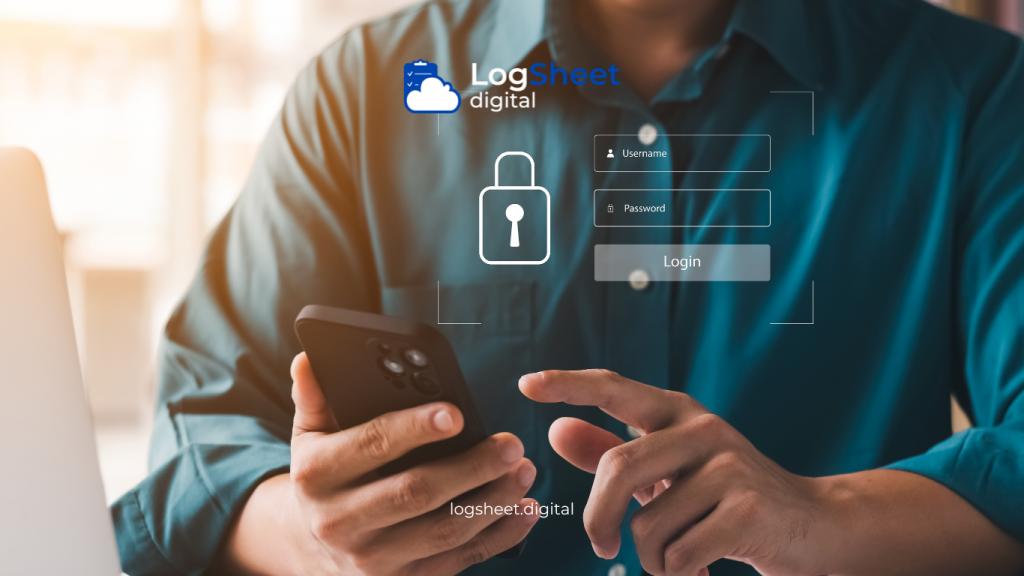In an increasingly digital era, companies face significant challenges in asset management and oversight. Assets must not only be monitored regularly but also secured to ensure optimal operation. The use of digital technology, such as digital logsheets, has emerged as an effective solution to enhance asset oversight and security. Digital logsheets not only automate data recording but also ensure better asset integrity through real-time monitoring. This article will discuss the application of digital logsheets in asset security oversight, the benefits they offer, and the challenges in their implementation.
What is a Digital Logsheets?

Read More: Enhancing Security and Quality of Delivery: Digital Logsheets in Logistics
Digital logsheets serve as platforms that automatically and digitally record and monitor asset data. They replace manual logsheets, which often prove inefficient and prone to errors. With digital logsheets, authorized personnel can easily access information related to asset conditions, maintenance schedules, and usage history. This system often integrates with Internet of Things (IoT) technology and cloud-based solutions, enabling automatic data recording and real-time monitoring.
Benefits of Digital Logsheets in Asset Security Oversight

Read More: Data Security in Digital Logsheets: Challenges and Security Strategies
1. Increased Transparency and Accountability
One of the main advantages of digital logsheets is the increased transparency in asset security oversight. Every activity performed on an asset can be recorded digitally and in detail. This allows asset managers to track who is responsible for any changes or activities, such as maintenance, inspection, or usage. With this transparency, companies can more easily identify discrepancies or issues that may arise in asset management.
2. Real-Time Monitoring
Asset security oversight becomes more effective with digital logsheets due to real-time monitoring. These systems can send automatic alerts if abnormal changes occur in an asset, such as detecting damage or unauthorized access. With always-updated information, security teams or asset managers can quickly take preventive actions before issues escalate.
3. Reduced Risk of Asset Loss or Damage
By monitoring assets regularly and automatically, the risk of asset loss or damage can be minimized. Digital logsheets provide notifications or alarms when detecting potential damage or unauthorized access to assets. This enables faster preventive measures, preventing greater losses.
4. Automated Recording and Reporting
Accurate recording is key in asset security oversight. Digital logsheets allow for automatic and timely data recording, eliminating human error that often occurs in manual systems. Additionally, the system automatically processes the collected data into informative reports, helping asset managers and security teams make informed decisions based on the available information.
5. Easy and Quick Data Access
Digital logsheets connected to the cloud allow for data access from various devices, anytime and anywhere. This facilitates management or security teams in monitoring assets remotely, without needing to be physically present at the asset location. With quick and easy access to data, preventive or corrective actions can be taken immediately when necessary.
6. Enhanced Data Security
In addition to enhancing the physical security of assets, digital logsheets provide an extra layer of security for the asset data itself. Encryption and authentication systems protect digitally stored data, ensuring that only authorized individuals can view or modify the information. This approach keeps data about assets secure and prevents unauthorized access.
Application of Digital Logsheets in Various Sectors

Read More: Digital Logsheets and Sustainability: Optimizing Resource Use in Workshops
1. Manufacturing Sector
In the manufacturing industry, teams must prioritize the security of assets such as production machines and factory infrastructure. Digital logsheets enable real-time monitoring of machine conditions, allowing teams to prevent damage before operational disruptions occur. Additionally, digital recording ensures that every maintenance action gets documented well and can be reviewed at any time.
2. Energy and Utilities Sector
Companies operating in the energy sector, such as power plants or oil and gas companies, have critical assets that must always be secured. Digital logsheets allow for continuous monitoring of infrastructure such as turbines, pipes, or electrical transformers, with notifications if there are signs of problems. This helps prevent accidents caused by technical failures or equipment malfunctions.
3. Transportation Sector
In the transportation industry, teams must closely monitor assets like vehicle fleets, ships, or aircraft to ensure security and operational safety. Digital logsheets allow users to record usage history, inspections, and maintenance of these assets, making it easier for security teams to ensure everything operates according to standards.
4. Healthcare Sector
Hospitals and healthcare facilities have many valuable assets, such as medical equipment and supporting infrastructure. Using digital logsheets in asset security oversight helps hospitals keep equipment in good condition, reducing the risk of damage that could affect patient care.
Steps to Implement Digital Logsheets in Asset Security Oversight

Read More: Towards Industry 4.0: Transforming Industry with Digital Logsheets
1. Identify Assets to be Monitored
The first step in implementing digital logsheets is to identify which assets need monitoring. Critical assets, such as production machines, vehicles, or technology equipment, should be prioritized for oversight. By determining these important assets, companies can focus their oversight and management efforts on areas that truly require attention.
2. Choose the Right Digital Logsheets Platform
There are various digital logsheets platforms available on the market, each with different features. Companies should choose a platform that fits their asset management and oversight needs. Factors such as ease of use, integration capabilities with other systems, and data security should be considered in selecting the right solution.
3. User Training
Once the platform is chosen, it is important to train employees responsible for asset oversight. Users need to understand how to access data, record information, and respond to alerts generated by the digital logsheets. This training also aims to ensure that all users can maximize the use of this technology.
4. Integration with Other Management Systems
Digital logsheets should ideally integrate with other management systems, such as ERP or maintenance management systems. This integration allows teams to use data collected from digital logsheets for more strategic planning and decision-making, and it enables broader process automation.
5. Regular Monitoring and Evaluation
After implementation, companies should routinely monitor and evaluate the effectiveness of using digital logsheets. This periodic evaluation aims to ensure that the system operates well and provides the expected benefits. If problems or challenges are found, improvements should be made promptly to ensure smooth asset oversight.
Challenges in Implementing Digital Logsheets

Read More: Improving Accuracy of Quality Control with Digital Logsheets
1. Implementation Costs
Although digital logsheets offer many benefits, the initial costs for adopting this technology can be a challenge, especially for small companies. The investment required for software, hardware, and employee training needs to be carefully considered.
2. Dependence on Technological Infrastructure
Digital logsheets require adequate technological infrastructure, including a stable internet connection and supporting devices. If this infrastructure is not available or frequently experiences disruptions, the digital logsheets system may not function optimally.
3. User Adaptation
Users accustomed to manual systems may require time to adapt to digital logsheets. Changes in work culture and adequate training will be necessary for users to effectively utilize this system.
Conclusion

Read More: Overcoming Implementation Challenges of Digital Logsheets in Logistics Environments
The application of digital logsheets in asset security oversight provides numerous benefits for companies, ranging from real-time monitoring to increased transparency and accountability. With this technology, companies can reduce the risk of asset loss or damage while ensuring the security of data related to assets. Although there are some challenges in its implementation, the long-term benefits provided by digital logsheets are clearly greater. The use of digital logsheets is an important step in enhancing the efficiency and security of asset management across various industrial sectors.






comments (0)